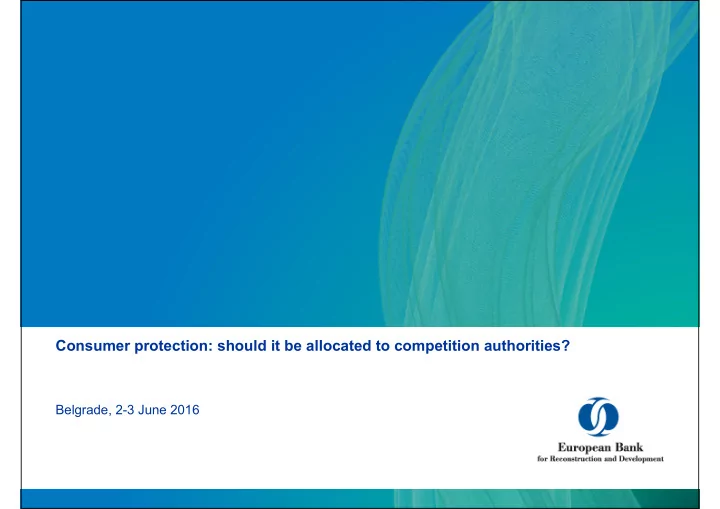

Consumer protection: should it be allocated to competition authorities? Belgrade, 2-3 June 2016
Consumer protection: should it be allocated to competition authorities? Outline of the discussion The interplay between consumer protection and competition policy Does “irrational behavior” justify a paternalist approach to consumer protection? Institutional design features: the case for integration and separation of the two policies Conclusive remarks
The interplay between consumer protection and competition policy Competition and consumer policy share the same fundamental objective to deliver well-functioning market/protect consumer welfare They approach the objective from two different angles Competition policy – supply side tool to address anti-competitive conducts by firms Consumer policy – demand side tool to address consumers’ imperfect information Competition policy aims at protecting the range of choices available to consumers – consumer policy aims at protecting the quality of those choices
The interplay between consumer protection and competition policy The two policy instruments can be used to advance the goal pursued by the other Competition policy can alleviate consumer protection concerns (switching costs, role of reputation) Consumer protection interventions may force firms to compete on the merits At the same time, each instrument poses challenges for the other Liberalisation of previously highly protected markets (financial markets, network industries, professional services) Incumbents’ reaction to opening-up of markets Consumer protection interventions may have negative consequences for competition and competition policy
Does “irrational behavior” justify a paternalist approach to consumer protection? Cognitive limitations and consumer choice – departures from rational decision making (behavioural economics) Increased competition and “too many choices” could yield negative welfare results demand for more paternalist approach This approach overlooks two fundamental aspects: Profit maximizing firms have incentives to exploit gains from trade also when they arise from intense competition leading to complexity of choices (“confusopoly”) Costs of regulatory errors to be weighed against the benefits of a more pro-active intervention However, truth is that we assist to a proliferation of choices in many markets which exposes to risks the most vulnerable categories of consumers
Institutional design features: the case for integration and separation of the two policies Should consumer protection and competition policy be housed within the same organisation? Benefits of integration: The possibility to use the two instruments interchangeably (address competition issues in a sector in a systemic way) Avoid inconsistencies in policy setting – e.g. harmful consequences of consumer protection may be more easily revealed Sharing of expertise – relevance for small countries, manage resources more efficiently Gaining support for competition policy through consumer protection (and potentially vice-versa)
Institutional design features: the case for integration and separation of the two policies Costs of integration (or the limits to integration): Very different policies – especially in relation to the instruments used Competition law – administrative proceedings, litigation in courts, small number of cases, investigations can last long, need complex investigative tools (dawn raids) and economic analysis Consumer protection – much more varied set of instruments (conventional enforcement; standards, industry codes, professional regulation); highly sector specific, policy making more complex and decentralised; huge number of cases. More credibility to consumer protection with one authority Risk of focusing enforcement on “easy wins” from a political and media perspective and not invest in competition law
Conclusive remarks No clear and definitive answer on the main question The bottom line is that whatever formula – coordination should be ensured (protocols) Food for though for the round table – how is this debate “special for SEE countries”? Looking at the countries participating, different solutions seem to have emerged (two separate agencies; consumer protection within Government ministry; no single “house” for consumer protection; concurrent competencies)
Recommend
More recommend